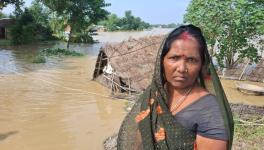Bihar: Maize Farmers’ Hope of Income Dashed by Strong Winds and Rains Damaging Standing Crops
Patna: Thousands of maize growing farmers, mostly marginal and small, suffered heavy loss in Bihar’s Seemanchal and Koshi regions following their crops being damaged due to thunderstorms and rain in the last two days. What worries these maize farmers is that the local weather office warns of likely more rain and strong winds in the next 24 hours.
After two bad years due to the COVID-19 pandemic, Nazrul Islam, Satnarayan Yadav, Tanveer Alam, and Lokesh Jha, all maize growing farmers, were hoping to make up for losses this summer. But high-speed winds and rains badly damaged their maize crops and dashed all their hopes of a bumper harvest next month.
“It has been dry weather since March and we were not expecting anything like strong thunderstorms with rain. Our maize crops, which were about to be ready for harvest in the next two to three weeks, were damaged. Whom to blame and whom to seek justice from as climate change is toying with us. Maize is a major source of livelihood and a big hope for most farmers,” said Islam, a resident of Jokihat in the Araria district.
Islam’s pain was echoed by Yadav, another maize farmer who was left upset. “During the pandemic in 2020 and 2021, maize growing farmers were forced to distress sell their produce due to poor demand. This year, we expected to make a decent income from good yields. But standing maize crops either broke, fell on the ground, or were destroyed by the strong winds, thunderstorms, and rains,” said Yadav, who had grown maize in three and a half acres of land in Thakurganj block in Kishanganj district.
Similarly, Alam said rain accompanied by strong winds damaged his maize crops. “My maize crops, which were standing till Tuesday night, are now bowing to the field and damaged thanks to strong winds and rains. The government should provide us with compensation for this heavy loss again,” said Alam, a resident of Azamnagar in the Katihar district.
Alam recalled heavy rains due to Cyclone Yaas last May damaged harvested maize crops and those that were standing.
Jha said heavy damage to standing maize crops had broken the spine of farmers. “Like me, most of the maize growing farmers were waiting for harvest as there was hope for a good profit in 2022 after a gap of two years. Untimely thunderstorms, rains, and strong winds ended everything.” Jha, a resident of Nauhatta in Saharsa district, said.
Islam, Yadav, Alam and Jha are four of thousands of helpless farmers whose standing maize crops were damaged. They were expecting a good return from “yellow gold”, as corn is locally known, after putting in months of hard labour and heavy investment.
In recent years, the flood-prone Seemanchal region and the Koshi region have emerged as a hub of maize cultivation. According to official data, maize has become the primary crop for farmers in Purnea, Kishanganj, Araria, and Katihar districts of Seemanchal. Madhepura, Saharsa, Supaul, and Khagaria districts of Koshi have suffered from the same phenomenon. Maize is also cultivated on a large scale by farmers in Bhagalpur and Samastipur districts.
A senior official of the agriculture department in Patna admitted that standing maize crops along hundreds of hectares were damaged and maize growing farmers have suffered heavy loss. “The government has its own official process to get reports of crop damage or loss to provide financial input to farmers. The concerned district officials have been asked to assess the damage and report to the department.”
Araria Agriculture officer Sanjay Kumar Sharma said he has directed all block agriculture officers to assess the damage to standing maize crops and report. “There is nothing to hide; maize crops were damaged, and farmers have approached him for compensation for this loss.”
Heavy loss of maize growing farmers was also confirmed by Ashok Pandit, weather scientist from the agricultural research centre in Supaul. “More than rains, strong winds fell standing crops, broke and damaged them.”
He said Supaul recorded 12 mm rainfall on Tuesday night, Saharsa 6.9 mm, and Katihar 10 mm.
Katihar Agriculture officer Dinkar Kumar said, “It is true maize growing farmers have become victims of erratic weather. Last year, harvested crops were damaged during the harvest season due to knee-deep water in the field after heavy rains occurred for four days due to the cyclone. Before that, farmers suffered heavy losses due to the lockdown, which resulted in a price crash after demand was hit.”
Mahendra Yadav, convenor of Koshi Nav Nirman Manch (KNNM), said maize growers are not getting MSP for their crops and are left at the mercy of traders who exploit them. “We have been demanding MSP for maize farmers like paddy and wheat growers. But the government has ignored us till date,” he added.
Yadav had filed a PIL in the Patna High Court in June last year, seeking a direction from the state government to procure maize at MSP from farmers. The court refused to issue any direction in the matter.
According to officials from the state agriculture department, nearly 65% of the total maize from Bihar is grown in the Seemanchal and Koshi regions. As per government data, maize is grown on about 1,40,000 hectares in the Seemanchal region and over about 90,000 hectares in the Koshi region.
More than 17 lakh MT of maize is grown annually in these regions. Of this, more than 14 lakh MT is purchased by traders and MNCs and sent outside the area, while around three lakh MT is consumed locally, according to data till 2019.
Bihar is India’s third-largest producer of maize. The state produced 1.36 million tons of the crop in 2005-06. This increased to 3.85 million tons in 2016-17, as the high-yielding maize of the Rabi season has been replacing the winter crops of wheat and paddy in the state.
Get the latest reports & analysis with people's perspective on Protests, movements & deep analytical videos, discussions of the current affairs in your Telegram app. Subscribe to NewsClick's Telegram channel & get Real-Time updates on stories, as they get published on our website.
























